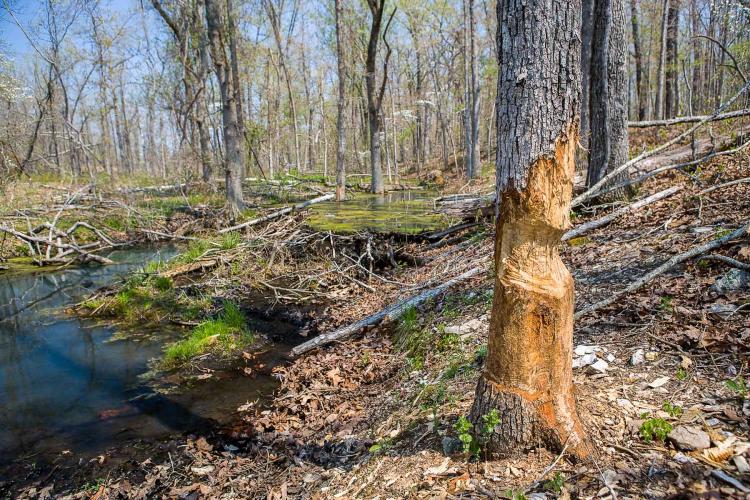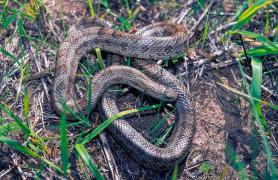
As humans, we tend to think of rivers as silvery singular ribbons coursing their way across the landscape. We imagine them as narrow blue lines meandering across a paper map. But it may be more accurate to contemplate Missouri’s rivers — particularly ones still in their natural state — as wide, shallow, braided places where moving streams of water momentarily connect only to dart away again.
Streams and rivers, marshes and ponds — these are the spaces American beavers call home. Aside from humans, few animals have the capacity to sculpt Missouri’s landscape the way beavers do.
Engineers by Nature
Biologists consider beavers “ecosystem engineers” because of their capacity to build dams and lodges and excavate dens.
“An ‘ecosystem engineer’ is an organism that alters the landscape in such a way that it’s responsible for creating entire ecosystems that other species are dependent on,” explained Michael Byrne, University of Missouri wildlife ecology assistant professor. “Beavers are particularly effective because of their capacity to harness the power of water.”
Nearly 87 percent of Missouri’s original wetlands have been lost over time due to human activity. By constructing dams, beavers create and maintain wetlands, providing habitat for countless plants, animals, birds, and insects. These wetlands also benefit humans by improving water quality, retaining sediments, reducing flood impacts, and providing a variety of opportunities for wildlife.
In places where water runs fast or flash flooding is an ever-present threat, beavers often dig an underwater tunnel into the riverbank to create their burrow, noted MDC Scientist Shelby Timm. But in quiet, shallow waters, they are more likely to construct a dam out of downed trees, limbs, vegetation, mud, and sometimes stones.
A lodge — a burrow often surrounded by a watery moat — is meant to be a shelter from inclement weather and predators. Dams are usually constructed some distance away from the lodge for the primary purpose of preventing the flow of water to create a pond. It is the placement of these water-diverting dams that have an outsized impact on our landscape.
A dam in the right place can cause a single channel to split into a braided steam, trigger an island to grow over time, and inundate a water meadow with rich alluvium.
By slowing water down — backing it up and giving it more room to spread — beaver dams reduce stream bank erosion. This also creates more arable land, an added benefit.
When erosion occurs and too much silt is deposited as sediment on a streambed, it clogs the interstitial spaces — the small gaps between larger gravel, pebbles, and cobbles — many species use as refuge.
“Sedimentation reduces critical habitat, and thus the carrying capacity, for not only crayfish, but many other macroinvertebrates,” said MDC Scientist Bob DiStefano. “Since both groups make up a very large part of the prey base in streams, their loss equals less food for wildlife.”
By downing trees and creating ephemeral wetlands, beavers naturally create the early-secessional habitat other species — warblers, herons, amphibians, otters, butterflies, kingfishers, and many more — need to thrive. And because of their ability to add biodiversity to the landscape, sometimes beavers even engineer the perfect niche an endangered species depends on to survive.
By felling some trees and not others, beavers create gaps in the canopy, increasing light to the forest floor and allowing more plants to grow. Where there are more plants, there are more insects, and where there are more insects there are more birds. And bats! A study in Poland found bat activity was “significantly higher in sections of valleys modified by beavers than in unmodified sections,” according to an article published in the European Journal of Wildlife Research.
By holding water back and allowing it to slowly seep into the ground, a beaver dam can slowly recharge the area’s groundwater and raise the water table — thus sustaining wildlife during dry summer seasons and drought.
Additionally, beaver dams are believed to have either neutral or positive impacts on fish stocks. MDC Fisheries Management Biologist Shane Bush said rainbow trout in Crane Creek — one of Missouri’s Blue Ribbon Trout areas — need flowing water and gravely riffles to spawn. Those conditions are sometimes thwarted in sections of the creek where beavers have created larger pools with slower moving water, he noted. “Now, this may inhibit some spawning in the section that is dammed, but these areas generally have higher densities of fish, since they create a larger, deeper area of water.”
Fly fishermen might prefer faster riffles for floating a fly, he explained. “However, in my experience, the areas behind beaver dams usually hold higher numbers of fish.”
Wetlands Systems Manager Frank Nelson believes beavers have the potential to improve the health of grasslands and benefit fens.
“On prairies, where headwater streams have become entrenched, beaver dams can slow the flow of water, allow sediment and nutrients to be deposited, and elevate the water table,” Nelson said.
And, if beavers are not naturally drawn to an upland drainageway, scientists can recreate and mimic their impact by installing ephemeral structures — posts and woven willow cuttings, for example — in places where beaver and human conflicts are low and stream restoration is needed.
Nelson is also hopeful maintaining or restoring beavers around fen complexes will help conserve these wetland areas’ rich botanical diversity. It is likely that beavers “have been an important part of plant succession over thousands of years and we are now just realizing their significant role in maintaining the biodiversity among these groundwater wetlands of Missouri,” he said.
No matter how hard humans work to recreate wildlife habitat, we can’t come close to replicating what beavers do for free, MDC Wildlife Damage Biologist Joe DeBold said. “I consider them a keystone species,” he said. “So many organisms are attracted to a beaver pool; it’s just so beneficial to have.”
“Beavers break up the landscape into a mosaic of different habitats,” Byrne agreed. “From a wildlife and ecosystem perspective, much of North America is the way it is because of beavers.”
Meet the Beavers
North America’s largest rodents primarily eat bark, particularly the bark of tender twigs and the greenish cambium layer of trees. Beavers along the Missouri River feed on cottonwoods and willows; in the Ozarks, they eat a much wider selection of trees. And beavers are known to eat their own scat — a second chance to extract nutrients from hard-to-digest woody pulp.
But they also eat nonwoody vegetation, such as corn, watercress, and the rhizomes of yellow pond lilies. And when these messy eaters drop sections of willows and lily rhizomes back into the water, the plants often re-root in the new location.
Because beavers are active all winter, they need a food source. To that end, they cache extra rations in a deep pool near the underwater entrance of their lodge or den or hide them beneath the roots of trees growing along the shore.
But why do they do it? Why do they build dams at all?
Scientists believe it’s an adaptation to survive extreme cold, the kind of frigid temperatures capable of freezing a waterbody solid. A dam creates a pool so deep it can’t freeze, even in the coldest conditions, preserving an under-the-ice avenue for the beavers to access their food cache even on the coldest days.
Beavers also are prey species, noted MDC Wildlife Damage Biologist Daryl Damron. “When confronted by a coyote or dog, they’re helpless, really,” he explained. “But the more a beaver expands a pool of water by damming a stream, the safer it is. It gives them access to more and more food and that’s why they keep building their dams higher and higher.”
Agile in the water, beavers are awkward on land where they are at the highest risk of predation. Although they must collect food on land, they prefer water’s protection. An underwater lodge entrance provides further refuge from most predators.
Perfectly Adapted
Over the eons, these semi-aquatic mammals evolved numerous adaptations to their cold and watery habitats. For example, their eyes have nictating membranes — translucent eyelids — that act like underwater goggles. Ample lungs and enlarged livers that store oxygenated blood allow beavers to stay underwater for 15 minutes at a time.
But it is the versatility of a beaver’s tail that is remarkable. An aid in swimming, beavers use their tails as rudders and to summon quick bursts of speed. A loud slap can startle a predator into revealing its position or provoke a momentary pause — enough time for the beaver to dive out of sight. Capable of storing excess fat, tail size waxes and wanes with the seasons. The tail also regulates temperature. Too hot? It can dissipate heat in the surrounding cooler water. Too cold? It uses a network of arteries called a rete mirabile — Latin for “wonderful net” — to prevent heat loss by cooling the blood before it reaches the tail. And, it makes a handy support prop when cutting down a tree.
Beavers are mostly nocturnal but may come out during the day in remote or protected areas. And they’re more active on land in autumn, when there’s much work to be done caching food and building dams.
Beavers and Humans: It’s Complicated
Beavers and humans have a complicated history.
In primitive times, perhaps 60 million beavers lived throughout most of North America. But the search for beaver pelts to be fashioned into high hats was one of the inducements for the exploration of the continent. By 1900, because of extensive trapping and other by-products of civilization, most beavers were extirpated throughout much of their former range. But restorations, protection, and management by conservationists helped reestablish this species throughout North America.
In Missouri, prior to the Civil War, beavers were common in every watershed. But by 1895, only a few colonies remained. The repopulation of the Missouri River and its tributaries in north Missouri is a result of colonization by either the original population or by migrants further upstream. Most of the beavers now living in southern Missouri presumably are the descendants of only six pairs purchased from Minnesota and released in 1928 and 1929. Some beavers in southwest Missouri may have migrated in from the west.
From 1939 to 1955, a continuous program of trapping beavers from places of heavy population and releasing them in areas with low or no population resulted in the reestablishment of this species throughout all the waters of the state.
Beavers: The Bad Boys of Nature
Beavers have developed a “bad reputation” with many landowners, said MDC Wildlife Damage Biologist Joe DeBold. But he feels the general public’s negativity toward beavers can be unwarranted. When meeting with property owners, he often chats with them about the myriad of benefits beavers provide.
But there are situations when deterring or removing beavers is a reasonable course of action. If mature hardwoods, human habitation, or agricultural land is being threatened, those are circumstances where removing beavers makes sense, DeBold said.
“For the most part, beavers tend to feed on low-quality, bottomland trees — cottonwoods, honey locust — that have little to no value for logging,” he said. “Beavers will avoid eastern black walnuts, which do have value, probably because those trees excrete an unpleasant chemical. I often tell landowners, ‘The beavers are doing you a favor because they’re weeding out low-quality timber.’”
Pond owners often are certain beavers will damage their dams. DeBold tries to quell their fears. It doesn’t always happen and when it does, it’s possible to discourage the mammals with “beaver deceivers,” metal cages that cover a pipe. Often constructed from tightly woven wire panels, these baffles frustrate the beaver and prevent the animal from blocking the pipe’s flow.
“Flooding can be an issue,” DeBold said.
The most effective way to head off beaver-related flooding problems is to hire a fur trapper to remove these mammals. Conibear traps and live-catch foothold traps are two common solutions, he noted. “I either offer technical assistance to help the landowner weigh his or her options. Or I recommend a local fur trapper from within the same county to do the work,” he said.










Also In This Issue

The dangers of being confused for your “evil” twin

Fire towers in Missouri
And More...
This Issue's Staff
Editor - Angie Daly Morfeld
Associate Editor - Larry Archer
Photography Editor - Cliff White
Staff Writer - Kristie Hilgedick
Staff Writer - Joe Jerek
Staff Writer – Dianne Van Dien
Designer - Shawn Carey
Designer - Marci Porter
Photographer - Noppadol Paothong
Photographer - David Stonner
Circulation Manager - Laura Scheuler






















